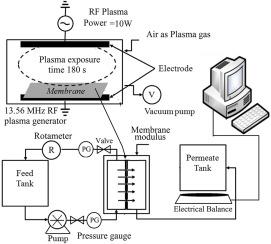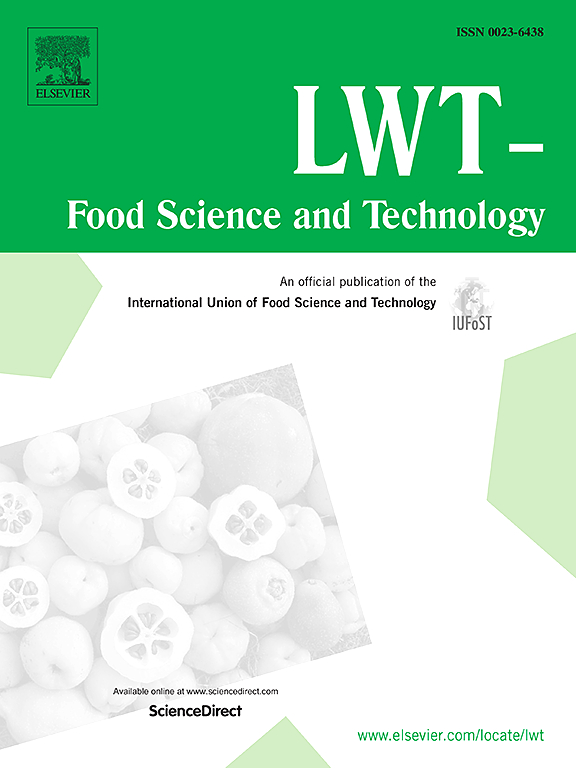使用冷等离子体处理混合纤维素酯膜澄清苹果汁:通量建模、膜堵塞和果汁理化特性评估
IF 6
1区 农林科学
Q1 FOOD SCIENCE & TECHNOLOGY
引用次数: 0
摘要
本研究旨在使用未改性和低压冷等离子体(气体:空气,功率:10 W,曝光时间:180 s)表面改性混合纤维素酯(MCE)微滤膜澄清苹果汁。采用响应面方法(RSM)评估了进料压力(20、40 和 60 kPa)、进料流速(10、15 和 20 mL/s)和进料温度(27 和 40 °C)对渗透通量的影响。进料压力和温度的二阶交互作用以及进料压力和流速的二阶(非线性)交互作用对渗透通量有显著影响(P < 0.05)。一般来说,在 60 kPa、15 mL/s 和 40 °C 的条件下,渗透通量最大。在最佳工艺条件下,对 MCE 膜进行冷等离子体表面改性可将渗透通量提高约 45%。膜堵塞评估显示,在两种膜处理过程中,滤饼形成是最主要的膜堵塞机制。理化性质评价显示,表面改性膜生产的澄清苹果汁的抗氧化活性、还原糖、总糖、酚和维生素 C 含量分别比未改性 MCE 膜生产的澄清苹果汁高出约 18.87%、12.9%、15.49%、24.53% 和 45.15%。本文章由计算机程序翻译,如有差异,请以英文原文为准。

Clarification of apple juice using cold plasma treated mixed cellulose esters membrane: Flux modeling, membrane fouling, and juice physicochemical properties evaluation
This study aimed to clarify apple juice using unmodified and low-pressure cold plasma (gas: air, power: 10 W, and exposure time: 180 s) surface-modified mixed cellulose esters (MCE) microfiltration membranes. The effect of feed pressure (20, 40, and 60 kPa), feed flow rate (10, 15, and 20 mL/s), and feed temperature (27 and 40 °C) on the permeate flux was evaluated using response surface methodology (RSM). The binary interaction of feed pressure and temperature and the second-order (non-linear) interaction of feed pressure and flow rate had a significant effect on the permeate flux (P < 0.05). Generally, the process at 60 kPa, 15 mL/s, and 40 °C resulted in the maximum permeate flux. The cold plasma surface modification of the MCE membrane increased the permeate flux by about 45% at the optimum process conditions. Evaluation of membrane fouling showed that the cake formation was the predominant membrane fouling mechanism during both membrane processing. The physicochemical properties evaluation revealed that the surface-modified membrane produced clarified apple juice with antioxidant activity, reducing sugars, total sugars, phenolic, and vitamin C contents about 18.87%, 12.9%, 15.49%, 24.53%, and 45.15% more than clarified apple juice produced with unmodified MCE membrane, respectively.
求助全文
通过发布文献求助,成功后即可免费获取论文全文。
去求助
来源期刊

LWT - Food Science and Technology
工程技术-食品科技
CiteScore
11.80
自引率
6.70%
发文量
1724
审稿时长
65 days
期刊介绍:
LWT - Food Science and Technology is an international journal that publishes innovative papers in the fields of food chemistry, biochemistry, microbiology, technology and nutrition. The work described should be innovative either in the approach or in the methods used. The significance of the results either for the science community or for the food industry must also be specified. Contributions written in English are welcomed in the form of review articles, short reviews, research papers, and research notes. Papers featuring animal trials and cell cultures are outside the scope of the journal and will not be considered for publication.
 求助内容:
求助内容: 应助结果提醒方式:
应助结果提醒方式:


